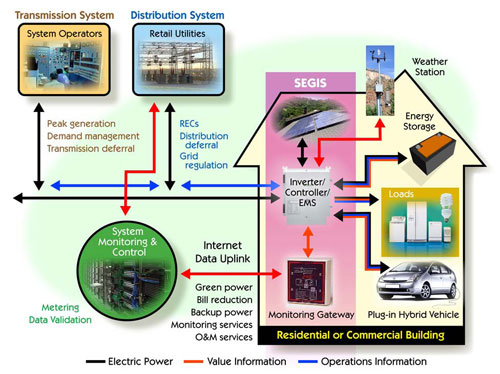Solar Energy Grid Integration Systems
Solar Energy Grid Integration Systems
Solar Energy Grid Integration Systems
The Solar Energy Grid Integration Systems (SEGIS), an effort of the Systems Integration subprogram, was launched to develop advanced photovoltaic (PV) systems with intelligent interfaces to seamlessly integrate into the distribution and transmission grid.
Adding intelligent interfaces to a PV system helps create a smart grid that will handle two-way flows of power and communication, in comparison to the one-way power flow and virtually no communication that exist today. An intelligent interface communicating with a smart grid is required to allow the seamless integration of solar technologies in high-penetration scenarios—while simultaneously helping solar energy generation achieve grid parity with conventional forms of electricity.

This illustration depicts the SEGIS concept with the two-way flows of power and communication required to enable seamless PV interconnections to the electric grid with high levels of solar energy.
In 2008, the Solar Energy Technologies Program (Solar Program) awarded financial assistance to 12 companies, through Sandia National Laboratories, to develop smarter and more interactive components and systems. In 2009, five of these companies received additional funding. These systems include inverters, controllers, and energy management systems that will use intelligent functionality and communication to optimize system performance, economic value, energy storage, and energy management.
Through these industry partnerships, the Solar Program is able to assist in the commercialization and deployment of next-generation, solar energy technologies. The development of advanced software and hardware will better optimize the flow of solar power and enhance grid reliability and power quality.
Another focus of SEGIS is to mitigate the intermittency of the solar resource, caused by cloud cover or shading for example, with energy storage and energy management. In the near future, these SEGIS activities will address intermittency mitigation, utility grid support, and system optimization for intelligent grid integration.



